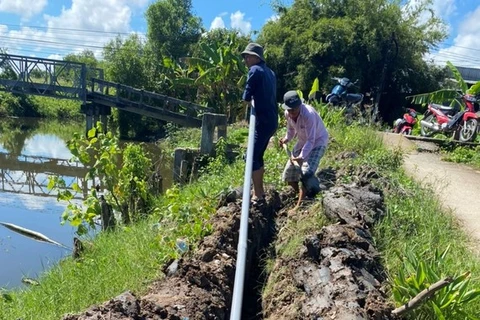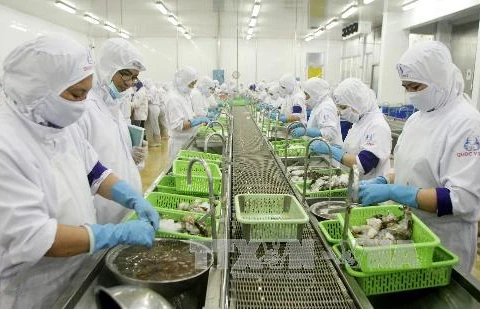Ca Mau (VNA) - The Mekong Delta province of Ca Mau plans to diversify its aquaculture and farming models to develop them effectively and sustainably.
The country’s southernmost province and largest shrimp producer has more than 300,000ha of aquaculture ponds, including 280,000ha to raise shrimp.
It plans to expand efficient shrimp farming models such as shrimp-rice, shrimp-forest and super-intensive shrimp farming this year, according to its Department of Agriculture and Rural Development.
The super-intensive farming area has increased from 175ha in 2016 to 4,322ha now.
The province has 80,000ha under the shrimp-forest model, with more than 19,000ha obtaining international quality certification such as GlobalGAP, Global Aquaculture Stewardship Council and Best Aquaculture Practices, according to the department.
In Ngoc Hien district, 9,300ha of shrimp-forest farming areas have international quality certification and an average yield of 200-240 kilogrammes a year, according to the local Bureau of Agriculture and Rural Development. The model is applied widely in areas in Ngoc Hien, Nam Can and Dam Doi districts with farmers breeding organic shrimp for both domestic distribution and exports.
Besides, Ca Mau province aims to expand the breeding of other aquatic species such as oysters, blood cockles, mud crabs, and marine fish this year. It has a coastline of more than 254 kilometres, many estuaries, mud flats and islands, and encourages farmers and companies to raise marine aquatic species.
The province targets seafood and aquaculture output of 640,000 tonnes this year, including 243,000 tonnes of shrimp, according to the department.
For this, it will zone shrimp farming areas and develop linkages among stakeholders to increase the farming area, efficiency and output, it said.
The output last year was 622,000 tonnes after increasing by 2.2%. Of this, 386,000 tonnes were from aquaculture, 5.3% up from 2021.
It exported more than 1.3 billion USD worth of shrimp last year, an increase of 16.5%.
The province has around 32 shrimp processing plants, which are equipped with advanced facilities and have an annual capacity of 250,000 tonnes.
The shrimp industry provides livelihoods to more than 600,000 people, or half the province’s population./.
The country’s southernmost province and largest shrimp producer has more than 300,000ha of aquaculture ponds, including 280,000ha to raise shrimp.
It plans to expand efficient shrimp farming models such as shrimp-rice, shrimp-forest and super-intensive shrimp farming this year, according to its Department of Agriculture and Rural Development.
The super-intensive farming area has increased from 175ha in 2016 to 4,322ha now.
The province has 80,000ha under the shrimp-forest model, with more than 19,000ha obtaining international quality certification such as GlobalGAP, Global Aquaculture Stewardship Council and Best Aquaculture Practices, according to the department.
In Ngoc Hien district, 9,300ha of shrimp-forest farming areas have international quality certification and an average yield of 200-240 kilogrammes a year, according to the local Bureau of Agriculture and Rural Development. The model is applied widely in areas in Ngoc Hien, Nam Can and Dam Doi districts with farmers breeding organic shrimp for both domestic distribution and exports.
Besides, Ca Mau province aims to expand the breeding of other aquatic species such as oysters, blood cockles, mud crabs, and marine fish this year. It has a coastline of more than 254 kilometres, many estuaries, mud flats and islands, and encourages farmers and companies to raise marine aquatic species.
The province targets seafood and aquaculture output of 640,000 tonnes this year, including 243,000 tonnes of shrimp, according to the department.
For this, it will zone shrimp farming areas and develop linkages among stakeholders to increase the farming area, efficiency and output, it said.
The output last year was 622,000 tonnes after increasing by 2.2%. Of this, 386,000 tonnes were from aquaculture, 5.3% up from 2021.
It exported more than 1.3 billion USD worth of shrimp last year, an increase of 16.5%.
The province has around 32 shrimp processing plants, which are equipped with advanced facilities and have an annual capacity of 250,000 tonnes.
The shrimp industry provides livelihoods to more than 600,000 people, or half the province’s population./.
VNA
























